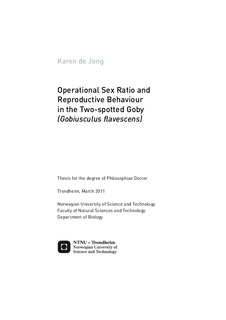| dc.contributor.author | de Jong, Karen | nb_NO |
| dc.date.accessioned | 2014-12-19T13:11:59Z | |
| dc.date.available | 2014-12-19T13:11:59Z | |
| dc.date.created | 2011-08-17 | nb_NO |
| dc.date.issued | 2011 | nb_NO |
| dc.identifier | 435221 | nb_NO |
| dc.identifier.isbn | 978-82-471-2739-1 (printed ver.) | nb_NO |
| dc.identifier.isbn | 978-82-471-2740-7 (electronic ver.) | nb_NO |
| dc.identifier.uri | http://hdl.handle.net/11250/244841 | |
| dc.description.abstract | Mating competition is an important process in sexual selection and can be expressed as complex courtship rituals and agonistic behaviours. The strength of mating competition is likely affected by mate availability. The operational sex ratio, the sex ratio of ready-to-mate individuals, reflects mate availability, and is therefore expected to affect competitive behaviour. This thesis explores the effect of operational sex ratio on competitive mating behaviour in the two-spotted goby ( Gobiusculus flavescens). In a field population of two-spotted gobies at the west coast of Sweden, sex roles switch from conventional (males competing for females) to reversed (females competing for males), within a reproductive season. This coincides with a change in the OSR from male-biased to female-biased.
In a laboratory study, we found an unexpected effect of OSR on courtship frequency (Paper I). Males courted more in a female biased OSR. Other competitive behaviours were not affected by OSR or overall density. In paper II, we argue that courtship frequency is affected by the frequency of encounters with potential mates as well as the motivation to court. Thus, frequency may not be the correct measurement of mating competition. We provide a simple model that explains the relation between OSR, encounter rates, courtship propensity and courtship frequency. The model shows that studies measuring courtship frequency could find opposite results to studies measuring courtship propensity. A meta-analysis shows that this is indeed the pattern that exists in the literature (Paper II). A second laboratory study measured male courtship behaviour both as frequency and propensity in two OSR-treatments that did not differ in density or adult sex ratio (Paper III). This study found that male courtship propensity was higher in a male biased OSR than in a female-biased OSR, as expected. Courtship frequency, on the other hand, did not differ between treatments. Moreover, courtship propensity was associated with the OSR at the time of observation, while courtship frequency was associated with encounter rates with potential mates.
Paper IV explores how reproductive behaviour changes over the breeding season in a natural population. Early in the season, more of the nests were occupied and males attending a nest early were larger (in 2008) or in better condition (in 2007) than males attending a nest late in the season. Brood size was associated with male size and nest size early in the season, but only with nest size late in the season. Late in the season, males received more visits from ready-to-mate females in one of the years (2008), but this did not result in more eggs in their nest (both years). Brood size was smaller and brood survival lower late than early in the season; brood survival was also associated with brood size (only data for 2008). These results indicate that males competed for breeding opportunities early in the season, when male density is high, while lower quality males postpone breeding to later in the season. This leads to the surprising suggestion that females are competing for low quality breeding opportunities late in the season. Thus, female breeding decisions warrant further investigation.
My main conclusions from this thesis are that male propensity to court is affected by OSR in the expected direction, but encounter rate is related to encounter rates rather than OSR. Thus, changes in frequencies of behaviour may be hard to interpret. Furthermore, knowledge of the biology of natural populations is crucial to the design and interpretation of laboratory experiments. | nb_NO |
| dc.language | eng | nb_NO |
| dc.publisher | Norges teknisk-naturvitenskapelige universitet, Fakultet for naturvitenskap og teknologi, Institutt for biologi | nb_NO |
| dc.relation.ispartofseries | Doktoravhandlinger ved NTNU, 1503-8181; 2011:103 | nb_NO |
| dc.relation.haspart | de Jong, Karen; Wacker, Sebastian; Amundsen, Trond; Forsgren, Elisabet. Do operational sex ratio and density affect mating behaviour?. Animal Behaviour. (ISSN 0003-3472). 78(5): 1229-1238, 2009. <a href='http://dx.doi.org/10.1016/j.anbehav.2009.08.006'>10.1016/j.anbehav.2009.08.006</a>. | nb_NO |
| dc.relation.haspart | de Jong, Karen; Forsgren, Elisabet; Sandvik, Hanno; Amundsen, Trond. Are we measuring mating competition correctly?. . | nb_NO |
| dc.relation.haspart | de Jong, Karen; Amundsen, Trond; Forsgren, Elisabet. Operational sex ratio affects male courtship propensity, but not courtship frequency, in the twospotted goby. . | nb_NO |
| dc.relation.haspart | de Jong, Karen; Cats Myhre, Lise; Wacker, Sebastian; Forsgren, Elisabet; Amundsen, Trond. Seasonal variations in reproductive behaviour of the two-spotted goby, a fish with dynamic sex roles. . | nb_NO |
| dc.title | Operational Sex Ratio and Reproductive Behaviour in the Two-spotted Goby (Gobiusculus flavescens) | nb_NO |
| dc.type | Doctoral thesis | nb_NO |
| dc.contributor.department | Norges teknisk-naturvitenskapelige universitet, Fakultet for naturvitenskap og teknologi, Institutt for biologi | nb_NO |
| dc.description.degree | PhD i biologi | nb_NO |
| dc.description.degree | PhD in Biology | en_GB |
